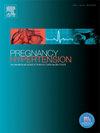无严重特征的妊娠高血压或先兆子痫的住院与门诊管理。
IF 2.9
4区 医学
Q2 OBSTETRICS & GYNECOLOGY
Pregnancy Hypertension-An International Journal of Womens Cardiovascular Health
Pub Date : 2024-12-11
DOI:10.1016/j.preghy.2024.101173
引用次数: 0
摘要
目的:比较门诊和住院治疗诊断为妊娠期高血压或无严重特征的子痫前期患者的孕产妇和新生儿结局。材料与方法:本研究为单中心、回顾性、队列研究,纳入2014年1月至2022年3月妊娠37周前高血压妊娠障碍(HDP)患者。病人被分类到住院或门诊管理在他们的产科医生的自由裁量权。最初表现为严重特征的患者被排除在外。采用双变量和多变量分析比较主要结局、由21种CDC孕产妇发病率标识符中的一种或多种定义的严重孕产妇发病率(SMM),以及产妇ICU入院、严重特征发展、胎盘早拆、从诊断到分娩时间、早产等次要结局。结果:共有272例患者符合纳入标准,其中门诊229例(84.2%),住院43例(15.8%)。在单因素分析中,门诊管理与较低的SMM发生率、从诊断HDP到分娩的间隔时间增加、出现严重特征的间隔时间增加以及产妇入住ICU的发生率降低相关。在多因素分析中,门诊管理仍然与SMM的低发生率(aOR 0.18, 95% CI 0.05-0.59)和新生儿结局的改善有关,5分钟APGAR评分低于7 (aOR 0.32, 95% CI 0.13-0.82)、低出生体重(aOR 0.37, 95% CI 0.17-0.79)和早产(aOR 0.31, 95% CI 0.15-0.67)的发生率较低。结论:HDP的门诊管理与较低的SMM率和不良的孕产妇和新生儿结局有关。虽然并非所有的混杂因素都被测量,但关于HDP管理设置的临床决策与良好的诊断能力相关。本文章由计算机程序翻译,如有差异,请以英文原文为准。
Inpatient versus outpatient management of gestational hypertension or preeclampsia without severe features
Objective
To compare maternal and neonatal outcomes in patients diagnosed with gestational hypertension or preeclampsia without severe features by outpatient versus inpatient management.
Materials and methods
This was a single center, retrospective, cohort study of patients with hypertensive disorder of pregnancy (HDP) before 37 weeks’ gestation from January 2014 to March 2022. Patients were triaged to inpatient or outpatient management at the discretion of their obstetrician. Patients with an initial presentation of severe features were excluded. Bivariate and multivariate analyses were used to compare the primary outcome, severe maternal morbidity (SMM) as defined by one or more of the 21 CDC maternal morbidity identifiers, and the secondary outcomes of maternal ICU admission, development of severe features, placental abruption, time from diagnosis to giving birth, preterm birth < 37 weeks, low birthweight (<2500 g), 5-minute Apgar score < 7, and stillbirth.
Results
A total of 272 patients met the inclusion criteria with 229 (84.2 %) being managed outpatient and 43 (15.8 %) managed inpatient. In univariate analysis, outpatient management was associated with lower incidence of SMM, an increased interval from diagnosis of HDP to giving birth, an increased interval to onset of severe features, and a lower incidence of maternal ICU admission. In multivariate analysis, outpatient management remained associated with lower odds of SMM, (aOR 0.18, 95 % CI 0.05–0.59) and improved neonatal outcomes with lower incidence of 5-minute APGAR score less than 7 (aOR 0.32, 95 % CI 0.13–0.82), low birth weight (aOR 0.37 95 % CI 0.17–0.79), and preterm birth (aOR 0.31, 95 % CI 0.15–0.67).
Conclusion
Outpatient management of HDP was associated with lower rates of SMM and adverse maternal and neonatal outcomes. While not all confounding factors were measured, the clinical decision regarding HDP management settings was associated with good diagnostic capability.
求助全文
通过发布文献求助,成功后即可免费获取论文全文。
去求助
来源期刊

Pregnancy Hypertension-An International Journal of Womens Cardiovascular Health
OBSTETRICS & GYNECOLOGYPERIPHERAL VASCULAR-PERIPHERAL VASCULAR DISEASE
CiteScore
4.90
自引率
0.00%
发文量
127
期刊介绍:
Pregnancy Hypertension: An International Journal of Women''s Cardiovascular Health aims to stimulate research in the field of hypertension in pregnancy, disseminate the useful results of such research, and advance education in the field.
We publish articles pertaining to human and animal blood pressure during gestation, hypertension during gestation including physiology of circulatory control, pathophysiology, methodology, therapy or any other material relevant to the relationship between elevated blood pressure and pregnancy. The subtitle reflects the wider aspects of studying hypertension in pregnancy thus we also publish articles on in utero programming, nutrition, long term effects of hypertension in pregnancy on cardiovascular health and other research that helps our understanding of the etiology or consequences of hypertension in pregnancy. Case reports are not published unless of exceptional/outstanding importance to the field.
 求助内容:
求助内容: 应助结果提醒方式:
应助结果提醒方式:


